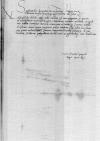Letter #128
Sigismund I Jagiellon to Ioannes DANTISCUSCracow, 1519-01-22
Manuscript sources:
Auxiliary sources:
Prints:
| ||||||||||||||||||||
Text & apparatus & commentaryPlain textText & commentaryText & apparatus
Nobili
Nobilis, fidelis dilecte.
Quia nobis multum est curae negotium, in quo te ad serenissimum dominum
Dat(ae) or Dat(um)⌈Dat(ae)Dat(ae) or Dat(um)⌉
Ad mandatum proprium


 BNW, BOZ, 953, f. 38v
BNW, BOZ, 953, f. 38v